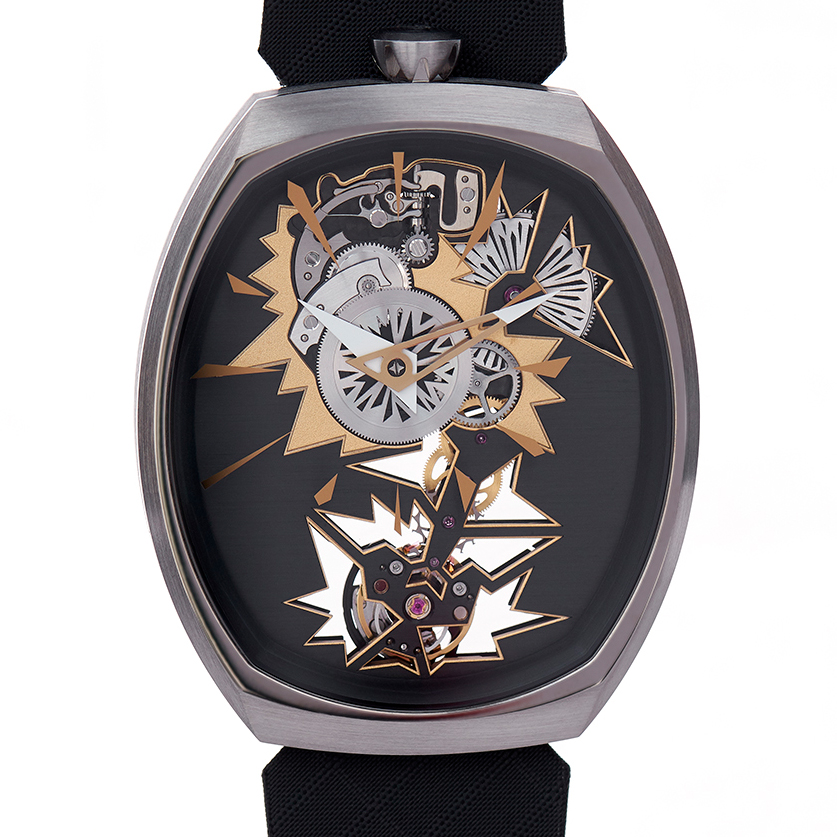
Mechanical Entropy
Power reserve: 50 h, 21600 vph
Skeleton movement
Mechanical Entropy
The First Timepieces from the Chaos Collection
Mechanical Entropy is the first design from Fiona Krüger’s second collection of timepieces – the Chaos collection.
Krüger combined the seemingly contradictory notions of order and perfection associated with fine watchmaking versus disorder and chaos, which describe the passing of time according to the laws of physics. These contrasting but related ideas were the basis around the creation of her designs and the development of the brands first exclusive calibre: Chaos I.
Mechanical Entropy highlights the beauty of the mechanical movement: a minimalistic case with generous front and back openings and no dial means the whole of the graphic movement is on show. The movement was designed to look as though it was mid-explosion, by stretching it out and in doing so revealing as many of the beautiful components as possible. The openings of the part-skeletonised calibre were drawn to highlight specific components, the look and position of each carefully considered in order to create this explosive calibre. Large graphic shard hands with white lacquer details indicate the time while metallic fragments on the underside of the sapphire act as hour indices, adding to the feeling of depth to this deceptively thin timepiece. The three part case acts as a subtle frame around the intricate movement, with it’s crown at 12h the only symmetrical element to this otherwise unconventional watch. In Mechanical entropy Krüger has captured a snapshot of the passing of time.
THE MOVEMENT
The gear train stretches out the length of the mechanism, displaying each wheel on the path towards the erupting balance wheel. The shattered hour and minute wheels have been pushed off-centre and the bursting barrel of the mainspring is visible through the exploding main plate and bridges in the top right of the movement. As you wind up your watch the barrel turns, animating the eruption. Each distinctive section of the beautifully finished movement is delicately framed by various size explosions, building up in layers from the movement’s bridges to the main-plate. The plates and bridges of the two-tone movement have a brushed finish with a black PVD coating, while the openings and the larger surface explosion on the font of the movement were created with laser technology and a galvanic colouring process in gold.
HANDS AND INDICES:
Polished shard hour and minute hands hover above the movement: a large white lacquer hand indicates the hours, and a skeletonized hand with lacquer detail indicates the minutes. Metallic fragments on the underside of the sapphire mark the hours. These floating indices add to the feeling of depth.
THE CASE
The 3-part watchcase acts as a subtle frame around the intricate movement. Its deceptively simple form follows the shape of the movement itself, with its crown at 12h the only symmetrical element to this otherwise unconventional watch. The case and crown have a mix of brushed and polished finishes, highlighting every angle and facet of their design.
THE NAME
Mechanical Entropy is named after the concept of entropy used in physics to explain the second law of Thermodynamics, and subsequently the passing of time.
Entropy. n.:
Lack of order or predictability; gradual decline into disorder
The second law of thermodynamics says that entropy always increases with time
Everyone has an intuitive understanding that time moves forward, that broken glass will not un-shatter, spilled milk will not un-spill. The scientific explanation of this is a concept called entropy, which explains that things always go from a state of order towards a state of disorder or chaos, but never the reverse. This is how we know time only moves forward (aka: the arrow of time).
Of course, if you delve deeper into the world of physics, we discover that one day your spilled milk may just un-spill – but we’ll leave that to the physicists to deal with!



